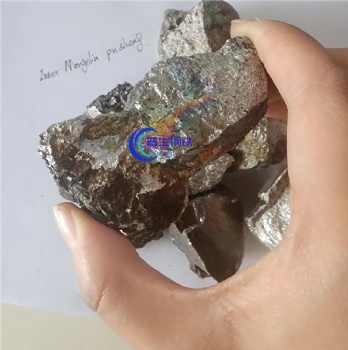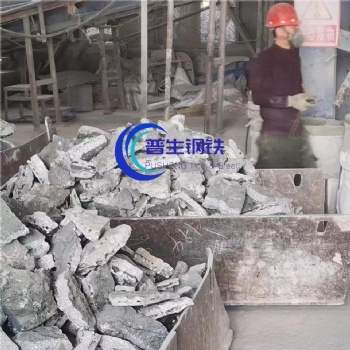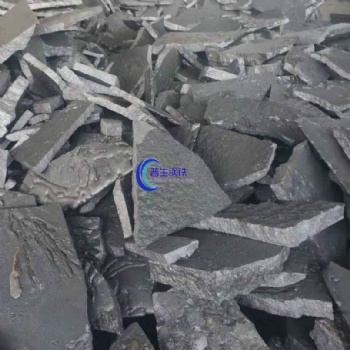News
Manganese ingot & production process
Manganese metal is mainly used in the production of stainless steel, high manganese steel, heat-resistant steel, tool steel, non-ferrous metal alloys (such as copper and aluminum alloys), as well as raw materials for producing soft magnetic materials (high-purity mnco3 and mn3co4), as well as for welding rod coatings, diamond contact coal, etc. Generally, manganese ingots are replaced by electrolytic metal manganese sheets. However, when using electrolytic metal manganese sheets, due to their larger surface area, they can cause severe oxidation and burning damage when used as alloy additives. Traditional pyrometallurgical smelting of metal manganese ingots has a long process, complex methods, low production, and serious pollution. The existing technology uses adding trace amounts of iron to melt metal manganese sheets in an intermediate frequency furnace to prepare metal manganese ingots. Metal manganese sheets are prone to oxidation at high temperatures, have low manganese recovery rates, severe pollution, low production, and higher costs than electrolytic metal manganese sheets
Metal manganese uses liquid hot manganese slag and silicon reducing agent to reduce manganese in manganese slag through silicon thermal reaction. The manganese recovery rate is high, the method is simple, the impurity content is low, and qualified metal manganese ingots can be smelted. The production method of metal manganese ingots includes the following steps: s1. refining the alloy, manganese ore, and white ash into a first refining furnace to obtain a first hot liquid manganese slag; S2. Put the first hot liquid manganese slag into the first shaking package, add a siliceous reducing agent, and shake for 5-9 minutes to obtain the hot liquid primary intermediate alloy; S3. Put the alloy, manganese ore, and white ash into the second refining furnace for refining to obtain metal manganese ingots and second hot liquid manganese slag; S4. Put the hot liquid primary intermediate alloy and the second hot liquid manganese slag into a second shaking package, shake and refine for 6-10 minutes to obtain the hot liquid secondary intermediate alloy; S5. Cycle the hot liquid secondary intermediate alloy into the second refining furnace, add hot liquid manganese rich slag and white ash to continue refining, and obtain the metal manganese ingot and the second hot liquid manganese slag again. Repeat steps s4-s5. Optionally, the power and volume of the first refining furnace are 2-3 times that of the second refining furnace, and the volume of the first shaking package is 1-2 times that of the second shaking package. Optionally, the alloy is silicon manganese alloy. Optionally, the silicon reducing agent has a silicon content greater than 92%, a fe content less than 2%, a c content less than 0.2%, a p content less than 0.02%, and a total content of ni, ti, ca, lead, and al less than 0.1%. Optionally, in s1, the mass ratio of manganese ore, alloy, and white ash is (12-13): (12-13): (6-7). Optionally, in s3, the mass ratio of the alloy, manganese ore, and white ash is (4-5): (8-10): (4-5). Optionally, the first hot liquid manganese slag comprises the following mass percentage components: 13-30% mno, 26-32% sio2, 29-38% cao, 1-3% mgo, 0-1% fe, 2-6% al2O3, with impurities remaining. Optionally, in the hot liquid primary intermediate alloy, the Mn content is higher than 65%, the Si content is higher than 30%, and the Fe content is lower than 3%. Optionally, in the s5, the hot liquid manganese rich slag contains more than 50% MnO, less than 20% SiO2, 4-10% CaO, 2-5% MgO, less than 1.5% Fe, 2-4% Al2O3, and less than 0.02% P2O5. Optionally, the manganese content in the hot liquid secondary intermediate alloy is higher than 85%, the silicon content is lower than 10%, and the iron content is lower than 3%. The production method of metal manganese ingots includes the following steps: s1. refining the alloy, manganese ore, and white ash into a first refining furnace to obtain a first hot liquid manganese slag; S2. Put the first hot liquid manganese slag into the first shaking package, add a siliceous reducing agent, and shake for 5-9 minutes to obtain the hot liquid primary intermediate alloy; S3. Put the alloy, manganese ore, and white ash into the second refining furnace for refining to obtain metal manganese ingots and second hot liquid manganese slag; S4. Put the hot liquid primary intermediate alloy and the second hot liquid manganese slag into a second shaking package, shake and refine for 6-10 minutes to obtain the hot liquid secondary intermediate alloy; S5. Cycle the hot liquid secondary intermediate alloy into the second refining furnace, add hot liquid manganese rich slag and white ash to continue refining, and obtain the metal manganese ingot and the second hot liquid manganese slag again. Repeat steps s4-s5. Metal manganese is refined using hot liquid refining slag and siliceous reducing agent, and shaken in a ladle to produce pure intermediate manganese alloy (hot liquid secondary intermediate alloy). The mass fraction of manganese element in the alloy can reach more than 85%, and the mass fraction of pure intermediate manganese alloy (hot liquid secondary intermediate alloy) is refined by hot blending to produce 96% metal manganese ingot. Compared with traditional methods, the raw materials and intermediate products in this application are both hot liquid, with low energy consumption and production costs. The hot liquid intermediate manganese alloy of metallic manganese can be directly refined in the furnace, and the process flow is simple and easy to operate, with a qualification rate of over 90%.




 售前客服
售前客服